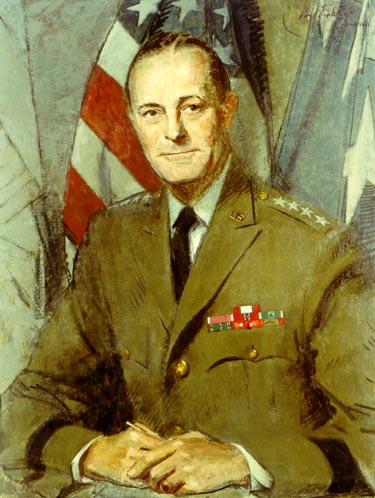
Earle Gilmore Wheeler was born in Washington, D.C., on 13 January 1908; graduated from the United States Military Academy, 1932; was commissioned a second lieutenant and served with the 29th Infantry at Fort Benning, 19321936; married Frances Rogers Howell, 1932; was promoted to first lieutenant, August 1935; completed the Infantry School regular course, 1937; served with the 15th Infantry in China and at Fort Lewis, 19371940; was promoted to temporary captain, September 1940; taught mathematics at West Point, 19401941; was aide to the commander of the 36th Infantry Division, 1941; graduated from the Command and General Staff College at Fort Leavenworth, 1942; was promoted to temporary major (February), permanent captain (June), and temporary lieutenant colonel (November), 1942; was a battalion commander, 141st Infantry, 36th Infantry Division, 1942; was promoted to temporary colonel, June 1943; was assistant chief of staff for operations of the 99th Infantry Division, 19421944, and chief of staff of the 63d Infantry Division in the final battles in Europe, 19441945; was instructor in combined arms training at the Field Artillery School at Fort Sill, 19451946; was assistant chief of staff for supply at the Western Base Section in Paris, 1946, and deputy chief of staff for operations of the United States Constabulary in Germany, 19471949; after reversion to peacetime rank, was again promoted to temporary ranks of lieutenant colonel, July 1947 (made permanent July 1948), and colonel, September 1950 (made permanent October 1953); graduated from the Army War College, 1950; was a member of the Joint Intelligence Group, Office of the Joint Chiefs of Staff, 19501951; commanded the 351st Infantry in Italy 19511952, and was briefly deputy commander of Trieste United States Troops, 1952; was promoted to temporary brigadier general, November 1952; was assistant chief of staff for plans and operations at Allied Forces Southern Europe headquarters, Naples, Italy, 19521955; was promoted to temporary major general, December 1955; was director of plans in the Office of the Deputy Chief of Staff for Plans and Operations, 19551957; was assistant deputy chief of staff for military operations, 19571958; commanded the 2d Armored Division at Fort Hood, 19581959, and III Corps there, 19591960; was promoted to temporary ranks of lieutenant general, April 1960, and general, March 1962, and permanent ranks of brigadier general, May 1960, and major general, June 1961; was deputy commander in chief of the United States European Command, 1962; was chief of staff of the United States Army, 1 October 19622 July 1964; supervised a major reorganization of the Department of the Army, the deployment of troops in Cuban missile, school integration, and Vietnam crises, and tests of an air assault division concept and overseas reinforcement system; was chairman of the Joint Chiefs of Staff during most of the Vietnam War, 19641970; retired from active service, July 1970; died in Frederick, Maryland, on 18 December 1975.
The Artist
Lloyd Bowers Embrey (19131979), noted Washington portrait painter, exhibited widely during a 43-year career as an artist, and is represented in numerous collections in the United States and abroad. His work extended well beyond the confines of oil portraiture; his sculpture of President John F. Kennedy, for example, is displayed in New York Citys Harvard Club, and his bronze bust of Nikita Khrushchev, sculpted to commemorate the visit of the Russian premier to the United States, is in the Kremlin. In the military line, in addition to executing portraits of two of the Armys chiefs of staff, he painted the Arctic landscape surrounding the Thule Air Force Base in Greenland.
Earle Gilmore Wheeler
By Lloyd Bowers Embrey
Oil on canvas, 42" x 32", 1972
[136]

[137]